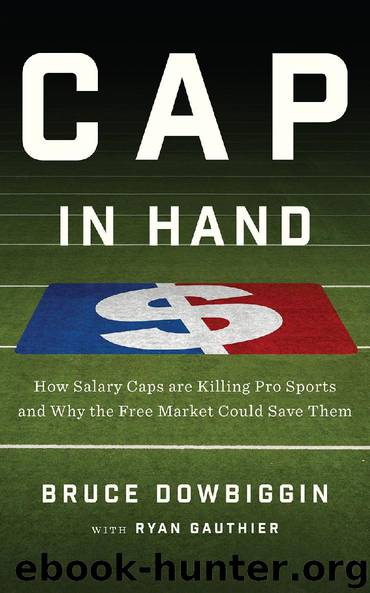Cap in Hand by Bruce Dowbiggin

Author:Bruce Dowbiggin
Language: eng
Format: epub
Publisher: ECW Press
Published: 2018-09-11T00:00:00+00:00
Part 2
Sports and the Law: The Fine Print
The first part of this book discussed the business reasons why professional team sports created the salary-cap model that now governs so much of pro sports. To understand why the salary cap is impacting the quality of competition, it’s important to understand the structure owners put into place to save themselves from themselves, and how the law prevents them from going further.
Professional sport is a completely different beast than it was during the time of Babe Ruth. On the one hand, players today have rights Ruth could only dream of: guaranteed contracts (except in the NFL), the exercise of free-agency rights and being paid well enough that they don’t need off-season jobs to make ends meet — like the one that NHLer Eddie Shack had in the 1960s, selling hats in Manhattan to supplement his $7,500 annual salary. Once their playing careers are over, today’s players may even be able to retire without working another day to support themselves.
On the other hand, there are similarities with how sports leagues operated back in the 1920s. Owners still exert near-total control over where players play for the early part of their careers. They can trade players to another city without the players’ consent (unless a star negotiates a no-trade or no-movement clause), and they continue to seek ways and means to limit the salaries of players. Often, owners escape media scrutiny for these tactics, as players are still seen in the eyes of the public as getting paid too much to “play a kids’ game.”
The contracts outlined in the first half of the book demonstrate the erosion of the owners’ power and the rearguard actions they employed to deal with the fallout each time the courts forced them to comply with labor law. The owners found out that, while they often had the upper hand, they lacked a completely free hand in implementing new systems to cover up the perceived problems with the player contracts that the owners themselves had drafted.
The actions of team owners were, and remain, ultimately constrained by two legal regimes — antitrust law and labor law (or “competition law” and “labour law” in Canada). To understand how the salary cap and other restrictions, such as the entry draft and limits on free agency, can exist in the first place, it is helpful to have a basic understanding of both of these areas of law. Bear with us here — we’ll make it as painless as possible.
Download
This site does not store any files on its server. We only index and link to content provided by other sites. Please contact the content providers to delete copyright contents if any and email us, we'll remove relevant links or contents immediately.
| Arms Control | Diplomacy |
| Security | Trades & Tariffs |
| Treaties | African |
| Asian | Australian & Oceanian |
| Canadian | Caribbean & Latin American |
| European | Middle Eastern |
| Russian & Former Soviet Union |
The Secret History by Donna Tartt(16708)
The Social Justice Warrior Handbook by Lisa De Pasquale(11503)
Thirteen Reasons Why by Jay Asher(7825)
This Is How You Lose Her by Junot Diaz(5819)
Weapons of Math Destruction by Cathy O'Neil(5070)
Zero to One by Peter Thiel(4861)
The Myth of the Strong Leader by Archie Brown(4806)
Promise Me, Dad by Joe Biden(4472)
Beartown by Fredrik Backman(4459)
How Democracies Die by Steven Levitsky & Daniel Ziblatt(4440)
Stone's Rules by Roger Stone(4434)
The Fire Next Time by James Baldwin(4365)
100 Deadly Skills by Clint Emerson(4103)
A Higher Loyalty: Truth, Lies, and Leadership by James Comey(4052)
Rise and Kill First by Ronen Bergman(4038)
The David Icke Guide to the Global Conspiracy (and how to end it) by David Icke(3908)
The Farm by Tom Rob Smith(3890)
Secrecy World by Jake Bernstein(3801)
The Doomsday Machine by Daniel Ellsberg(3749)
